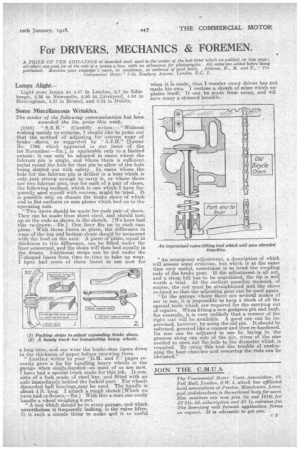For DRIVERS, MECHANICS & FOREMEN.
Page 23

If you've noticed an error in this article please click here to report it so we can fix it.
A PRIZE OF TEN SITIT,LINGS is awarded each week to the sender of the best letter which, we publish on this rage; all other; are paid for at the rate of a penny a line, with an. allowance for photographs. All notes are edited before being published. Mention your eniployer's name, in confidence, as evidence of good faith. Address, D., M. and P., " The Commercial Motor," 7-15, Rosebery Avenue, London, E.G. 1.
Lamps Alight—
Light your lamps at 4.47 in London, 5.7 inEdinburgh, 4.36 in Newcastle, 4.50 in _Liverpool, 4.50 in Birmingham, 4.57 in Bristol, and 5.34 in Dublin.
Some Miscellaneous Wrinkles.
The sender of the following communi been has awarded the Ws, prize this week.
[1818] " S.R.H." (Cardiff) writes : —"Without wishing unduly to criticize, I should like to point out that the method of adjusting for uneven wear of brake shoes, As suggested by " A:J.El." [Letter No. 1790, which a,ppeared in our issue of the 1st November.—ED.1, is applicable only to a limited extent: it can only be adopted in cases where the fulcrum: pin is single, and where there is sufficient metal round the hole for that pin to allow of the hole • being slotted out with safety. In cases where the hole for the fulcrum pm is drilled in a, boss which is only just strong enough to carry it, or where there are two fulcrum pins, one for each of a pair of shoes, the following method, which is one which I have frequently used myself with success, might be tried. It is possible only on chassis the brake shoes of which end in flat surfaces or cam plates which bed on to the operating cam.
Two liners should be made for each pair of shoes. They can be made from sheet steel and should turn up at the ends as shown in the sketch. [We have had this re-drawn.--EP.1 One liner fits on to each earn plate. With these liners in place, the difference in wear of the top and bottom shoes should be measured with the load on the axle. A piece orpla.te, equal in thickness to this difference, can be fitted under the liner concerned, and tlae shoes will then bed equally in the drums. Additional strips can be put under the U-shaped liners from time to time to take up wear. I have had some of these liners in use now for a long time, and can wear the brake-shoe liners down to the thickness of paper before renewing them.
"Another writer to your D.M. and E.' pages recently gave a tip for handling heavy wheels in the garage when single-handed—as most of us are now. I have had a special tr.-lick made for this job. It consists of a fork made of steel bar, and fitted with an axle immediately behind the forked part. For wheels discarded ball bearings. may be used. The handle is about 4 ft. long. I attach a. rough sketch [Which we have hid re-drawn.—En.] With this a, man can easily handle a wheel weighing 6 0\4.
"A tool which should be in every garage, and Which nevertheless is frequently lacking, is the valve It is such a simple thing to make a,nd: is so useful when it is made, that I wonder every driver has not made his own. I enclose a sketch of mine which explains itself. It can be made from scrap, and wil save many a skinned knuckle.
"An emergency adjustment, a description of which will arouse some criticism, but which is at the same time very useful, sometimes is to bend. the coupling rods of the brake gear. If the adjustment is all out, and a steep hill has to be negotiated, the tip is, well worth a. trial. At the earliest possible moment, of course, the rod must be straightened and the shoes re-lined so that the adjusting gear can be used again. "In the garage where there are several ,makes of car in use, it is impossible to keep a stock of all the special tools which are required for the carrying out of repairs. When fitting a, new gudgeon pin and bush, for example, it is very unlikely that a reamer of the right size will be available. A good one can be im.provised, however, by using the old pin. It should be softened, grooved like a reamer and then re-hardened. Its size can be adjusted in use by laying in the grooves along one side of the pin, wires of the size needed to open out the hole to the diameter which is required. By using this tool the trouble of unshipping the base chamber and removing the rods can be obviated."
























